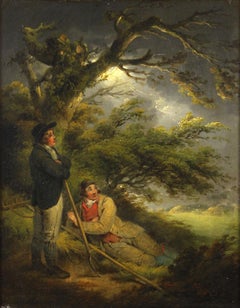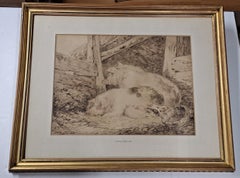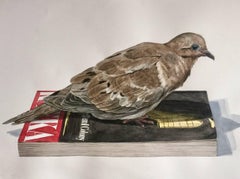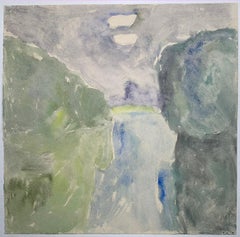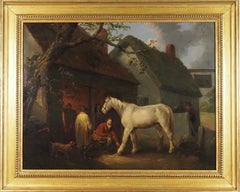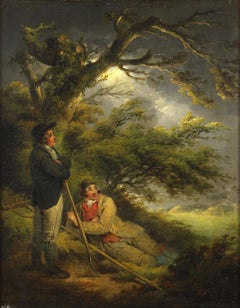George Morland Paintings
English, 1763-1804
George Morland (26 June 1763 in London – 29 October 1804 in Brighton) was an English painter. His early work was influenced by Francis Wheatley but after the 1790s he came into his own style. His best compositions focus on rustic scenes: farms and hunting; smugglers and gypsies; and rich, textured landscapes informed by Dutch Golden Age painting.to
1
3
1
Overall Width
to
Overall Height
to
4
4
3
1
4
3
1
1
1
1
1
4
2
2
1
8
785
694
655
649
4
2
2
Artist: George Morland
Sheltering from the storm / - Romantic landscape illuminated by lightning bolt -
By George Morland
Located in Berlin, DE
George Morland (1763 London - 1804 Brighton). Sheltering from the Storm. Oil on canvas, relined, 37.5 x 29.5 cm (visible size), 53.5 x 45.5 cm (...
Category
1790s Romantic George Morland Paintings
Materials
Oil
Conversation at the gate
By George Morland
Located in Douglas, Isle of Man
George Morland 1763-1804, was an English painter who was influenced by the painter Francis Wheatley , landscapes. After 1790 he had developed his own style of painting adopting rusti...
Category
18th Century George Morland Paintings
Materials
Watercolor, Paper
“Pair of Hunt Scenes, Oil on Canvas”
By George Morland
Located in Warren, NJ
This is 2 original oil paintings. Both are beautiful pieces. each lined and with craquelure; Meet by the Farmhouse with a chip in the paint along the left edge and an abrasion along ...
Category
18th Century George Morland Paintings
Materials
Oil
George Morland (1763-1804) "Piglets" Original Watercolor
By George Morland
Located in San Francisco, CA
George Morland (1763-1804) "Piglets" original watercolor on paper
Signed & Dated 1791
Unframed 14" x 18"
Framed 21" x 26"
Category
18th Century George Morland Paintings
Materials
Watercolor
Related Items
The Reader
By Thomas Broadbent
Located in New York, NY
Signed on reverse, 22"x30" available unframed.
Thomas Broadbent has shown extensively throughout the U.S. as well as internationally. Broadbent’s work won the Pulse Prize for best s...
Category
2010s Contemporary George Morland Paintings
Materials
Watercolor, Archival Paper
Russian Landscape (abstract painting)
Located in Wilton Manors, FL
Yuri Larin (1936-2014). Landscape, 1986. Watercolor on paper, 16.5 x 17 inches. Mounted on cardboard sheet measuring 24 x 28 inches. Signed and dated lower left. Excellent condition. Image is painted on verso side of block print wallpaper...
Category
1980s Abstract George Morland Paintings
Materials
Paper, Watercolor
George Edwards: 18th Century Engravings of Ducks And Wading Birds
By George Edwards
Located in Richmond, GB
George Edwards: ""A History of Uncommon Birds"", 1749-1761.
A prominent English naturalist and ornithologist, George Edwards (1694 -1773) is best known for his work, ""A Natural Hi...
Category
18th Century George Morland Paintings
Materials
Watercolor, Engraving
H 15.75 in W 13.75 in D 1 in
Horse Drawn Plough with Two Horses Ploughman and Dog by British Landscape Artist
By James Wright
Located in Preston, GB
Horse Drawn Plough with Two Horses, Ploughman and his Dog. Signed, Oil on Canvas, housed in a gilt frame, by British Landscape Artist, James Wright.
Art measures 24 x 16 inches
Fram...
Category
1990s Romantic George Morland Paintings
Materials
Canvas, Oil
H 20 in W 30 in D 2.992 in
'Scottish Landscape Scene, ' by E.J., Watercolor Painting
Located in Oklahoma City, OK
This one-of-a-kind watercolor landscape painting was created in 1910 by artist E.J. The artist perfectly captures the tranquility of the scene, featuring a palette of pastel colors, ...
Category
2010s Realist George Morland Paintings
Materials
Watercolor, Paper
Romantic British painter - 19th century landscape painting - Lake view
Located in Varmo, IT
English painter (late 19th century) - Romantic landscape fisherman at the lake.
41 x 66 cm.
Old oil painting on canvas, without frame.
Condition report: Lined canvas. Good state o...
Category
Late 19th Century Romantic George Morland Paintings
Materials
Canvas, Oil
"The Eastern Moon"
By Peter Sculthorpe
Located in Lambertville, NJ
Jim’s of Lambertville is proud to offer this artwork.
Signed lower right.
Complemented by a hand carved and gilt frame.
Peter Sculthorpe (b. 1948)
Peter Sculthorpe was born in ...
Category
21st Century and Contemporary American Realist George Morland Paintings
Materials
Linen, Oil
Christopher Street (abstract Greenwich Village cityscape)
By De Hirsch Margules
Located in Wilton Manors, FL
De Hirsh Margules (1899-1965). Christopher Street, 1939. Watercolor on Arches wove paper. Signed and dated in pencil by artist lower margin. Sheet measures 15.5 x 20 inches. Window in matting measures 15 x 19 inches. Framed measurement: 23 x 30 inched. Bears fragment of original label affixed on verso. Incredibly vibrant and saturated color with no fading or toning of sheet.
Provenance: Babcock Galleries, NYC
Exhibited: The American Federation of Arts Traveling Exhibition.
From the facade of The Waverly at Christopher is depicted One Christopher Street, the 16-story Art Deco residential building erected in 1931. It is not a casual coincidence that the structure appears in this cityscape: 1 Christopher Street is the subject. The original intention of this project was to transform the neighborhood, bring a bit of affluence and make a bid to rival the Upper West Side. Margules, a sensitive aesthete, understood how a massive piece of architecture such as One changes a neighborhood. Sound, scale and focal points are forever altered. A pedestrian's sense of depth and distance becomes pronounced. All of these factors contribute to the intent behind this image. Tall buildings disrupt the human scale, change the skyline and carve up space. In this piece, negative space conforms to the man-made geometries. Clouds become gems fixed in settings.
De Hirsh Margules (1899–1965) was a Romanian-American "abstract realist" painter who crossed paths with many major American artistic and intellectual figures of the first half of the 20th century. Elaine de Kooning said that he was "[w]idely recognized as one of the most gifted and erudite watercolorists in the country". The New York Times critic Howard Devree stated in 1938 that "Margules uses color in a breath-taking manner. A keen observer, he eliminates scrupulously without distortion of his material." Devree later called Margules "one of our most daring experimentalists in the medium"
Margules was also a well-known participant in the bohemian culture of New York City's Greenwich Village, where he was widely known as the "Baron" of Greenwich Village.[1] The New York Times described him as "one of Greenwich Village's best-known personalities" and "one of the best known and most buoyant characters about Greenwich Village.
Early Life
De Hirsh Margules was born in 1899 in the Romanian city of Iași (also known as Iasse, Jassy, or Jasse). When Margules was 10 weeks old, his family immigrated to New York City. Both of his parents were active in the Yiddish theater, His father was Yekutiel "Edward" Margules, a "renowned Jewish actor-impresario and founder of the Yiddish stage." Margules' mother, Rosa, thirty-nine years younger than his father, was an actress in the Yiddish theater and later in vaudeville. Although Margules appeared as a child actor with the Adler Family[11] and Bertha Kalich, his sister, Annette Margules, somewhat dubiously continued in family theater and vaudeville tradition, creating the blackface role of the lightly-clad Tondelayo (a part later played on film Hedy Lamarr) in Earl Carroll's 1924 Broadway exoticist hit, White Cargo. Annette herself faced stereotyping as an exotic flower: writing about her publicist Charles Bouchert stated that "Romania produces a stormy, temperamental type of woman---a type admirably fitted to portray emotion." His brother Samuel became a noted magician who appeared under the name "Rami-Sami." Samuel later became a lawyer, representing magician Horace Goldin, among others. A family portrait including a young De Hirsh, a portrait of Rosa and Annette together, and individual photos of Rosa and Edward can be found on the Museum of the City of New York website.
At around age 9 or 10, Margules took art classes with the Boys Club on East Tenth Street, and his first taste of exhibition was at a student art show presented by the club. By age 11, he had won a city-wide prize (a box camera) at a children's art show presented by the department store Wanamakers.
As a young teenager, Margules was already displaying a characteristic kindness and loyalty. Upon hearing that two friends (one of them was author Alexander King), were in trouble for breaking a school microscope, the nearly broke Margules gave them five dollars to repair the microscope . Margules had to approach a wealthy man that Margules had once saved on the subway from a heart attack. Margules didn't reveal the source of the five dollars to King until twenty-five years later.
In his late teens, Margules studied for a couple of months in Pittsburgh with Edwin Randby, a follower of Western painter Frederic Remington. Thereafter he pursued a two-year course of studies in architecture, design and decoration at the New York Evening School of Art and Design, while working as a clerk during the day at Stern's Department Store. He was encouraged in these artistic pursuits by his neighbor, the painter Benno Greenstein (who later went by the name of Benjamin Benno).
Artistic career
In 1922, Margules began work as a police reporter for the City News Association of New York .Margules then considered himself something of an expert on art, and the painter Myron Lechay is said to have responded to some unsolicited analysis of his work with the remark "Since you seem to know so much about it, why don't you paint yourself?" This led to study with Lechay and a flurry of painting.
Margules' first show was in 1922 at Jane Heap's Little Review Gallery. Thereafter Margules began to participate in shows with a group including Stuart Davis, Jan Matulka, Buckminster Fuller (exhibiting depictions of his "Dymaxion house") in a gallery run by art-lover and restaurateur Romany Marie on the floor above her cafe.
Jane Heap, left, with Mina Loy and Ezra Pound
During the 1920s, Margules traveled outside of the country a number of times. In 1922, with the intent of reaching Bali, he took a job as a "'wiper on a tramp steamer where [he] played nursemaid to the engine." He reached Rotterdam before he turned back. He would return to Rotterdam shortly thereafter.
In 1927, Margules took a lengthy leave of absence from his day job as a police reporter in order to travel to Paris, where he "set up a studio in Montmartre's Place du Tertre, on the top floor of an almost deserted hotel, a shabby establishment, lacking both heat and running water." He studied at the Louvre and traveled to paint landscapes in provincial France and North Africa.
Margules also joined the "Noctambulist" movement and experimented with painting and showing his artwork in low light.Jonathan Cott wrote that:
the painter De Hirsch Margulies sat on the quays of the Seine and painted pictures in the dark. In fact, the first exhibition of these paintings, which could be seen only in a darkened room, took place in [ Walter Lowenfels'] Paris apartment.
Elaine de Kooning remarked that studying the works of the Noctambulists confirmed Margules' "direction toward the use of primary colors for perverse effects of heavy shadow."
It was also in Paris that Margules initially conceived his idea of "Time Painting", where a painting is divided into sectors, each representing a different time of day, with color choices meant to evoke that time of day.
In Paris, his social circle included Lowenfels, photographer Berenice Abbott, publisher Jane Heap, composer George Anthiel, sculptor Thelma Wood, painter André Favory, writer Norman Douglas, writer and editor George Davis, composer and writer Max Ewing, and writer Michael Fraenkel.
Upon his return to New York in 1929, Margules attended an exhibition of John Marin's paintings.
While at the exhibition, he "launched into an eloquent explanation of Marin to two nearby women", and was overheard by an impressed Alfred Stieglitz. The famous photographer and art promoter invited Margules to dine with his wife, the artist Georgia O'Keeffe, and his assistant, painter Emil Zoler. Stieglitz thereafter became a friend and mentor to Margules, becoming for him "what Socrates was to his friends."
Alfred Stieglitz
Stieglitz introduced Margules to John Marin, who quickly became the most important painterly influence upon Margules. Elaine de Kooning later noted that Margules was "indebted to Marin and through Marin to Cézanne for his initial conceptual approach - for his constructions of scenes with no negative elements, for skies that loom with the impact of mountains." Margules himself said that Marin was his "father and ... academy." The admiration was by no means unreciprocated: Marin said that Margules was "an art lover with abounding faith and sincerity, with much intelligence and quick seeing." Stieglitz also introduced Margules to many other artistic and intellectual figures in New York.
With the encouragement of Alfred Stieglitz, Margules in 1936 opened a two-room gallery at 43 West 8th Street called "Another Place." Over the following two years there were fourteen solo exhibitions by Margules and others, and the gallery was well-respected by the press. It was in this gallery that the painter James Lechay, Myron's brother, exhibited his first painting.
In 1936, Margules first saw recognition by major art museums when both the Museum of Modern Art and the Museum of Fine Arts, Boston purchased his works.
In 1942, Margules gave up working as a police reporter, and apparently dedicated himself thereafter solely to an artistic vocation.
"The Baron of Greenwich Village"[edit]
Margules made his mark not only as an artist, but also as an outsized personality known throughout Greenwich Village and beyond.
To local residents, Margules was known as the "Baron", after Baron Maurice de Hirsch, a prominent German Jewish philanthropist. Margules was easily recognizable by the beret he routinely wore over his long hair. Writer Charles Norman said that he "dressed with a flair for sloppiness."
He was said to "know everybody" in Greenwich Village, to the extent that when the novelist and poet Maxwell Bodenheim was murdered, Margules was the first one the police sought to identify the body. Margules' letters show him interacting with art world figures such as Sacha Kolin, John Marin and Alfred Stieglitz, as well as with prominent figures outside the art world such as polymath Buckminster Fuller and writer Henry Miller.
Most of his friends and acquaintances found Margules a generous and voluble man, given to broadly emotionally expressive gestures and acts of kindness and loyalty. In 1929, he exhibited an example of this loyalty and fellow-feeling when he appeared in court to fight what the wrongful commitment of his friend, writer and sculptor Alfred Dreyfuss, who appeared to have been a victim of an illicit attempt to block an inheritance.
The Greenwich Village chronicler Charles Norman described the bone-crushing hugs that Margules would routinely bestow on his friends and acquaintances, and speaks of the "persuasive theatricality" that Margules seemed to have inherited from his actor parents. Norman also wrote about Margules' routine acts of kindness, taking in homeless artists, constantly feeding his friends and providing the salvatory loan where needed. Norman also notes that Margules was blessed with a loud and good voice, and was apt to sing an operatic air without provocation.
The writer and television personality Alexander King said
I think the outstanding characteristics of my friend's personality are affirmation, emphasis, and overemphasis. He chooses to express himself predominantly in superlatives and the gestures which accompany his utterances are sometimes dangerous to life and limb. Of the bystanders, I mean.
King also spoke with affectionate amusement about Margules' pride in his cooking, speaking of how "if he should ever invite you to dinner, he may serve you a hamburger with onions, in his kitchen-living room, with such an air of gastronomic protocol, such mysterious hints and ogliing innuendoes, as if César Ritz and Brillat-Savarin had sneaked out, only a moment before, with his secret recipe in their pockets."
Margules was such a memorable New York personality that comic book writer Alvin Schwartz imagined him at the Sixth Avenue Cafeteria in a risible yet poignant debate with Clark Kent about whether Superman had the ability to stop Hitler.
Margules' entrenchment in the Greenwich Village milieu can be seen in a photograph from Fred McDarrah's "Beat Generation Album" of a January 13, 1961 writers' and poets' meeting to discuss "The Funeral of the Beat Generation", in Robert Cordier [fr]'s railroad flat at 85 Christopher Street. Among the people in the same photograph are Shel Silverstein...
Category
1930s American Modern George Morland Paintings
Materials
Watercolor, Rag Paper
Coastal Mountain Cliff Beach Scene Northern Ireland by 20th Century Irish Artist
By David Overend
Located in Preston, GB
Coastal Mountain Cliff Beach Scene of Fair Head in Northern Ireland by 20th Century Irish Artist, David Overend.
Art measures 16 x 12 inches
Frame meas...
Category
Mid-20th Century Romantic George Morland Paintings
Materials
Canvas, Oil
1960s "Mountain Side" Watercolor Landscape California Gold Country Mid Century
Located in Arp, TX
Thelma Corbin Moody
AbEx Mountain Side
c. 1960's
Watercolor on Arches Paper
29.5" x 22", Unframed
Thelma Corbin Moody (1908-1986) of Modesto, CA....
Category
Late 20th Century American Realist George Morland Paintings
Materials
Paper, Watercolor
Romantic French painter - 19th century landscape painting - Stormy sea
Located in Varmo, IT
French painter (late 19th century) - Stormy sea.
61 x 91 cm.
Old oil painting on canvas, without frame.
Condition report: Original canvas. Good state of conservation of the pictor...
Category
Late 19th Century Romantic George Morland Paintings
Materials
Canvas, Oil
Dutch Winter Landscape at Sunset, 1842
Located in Stockholm, SE
This remarkable painting by Swedish artist Per Wickenberg captures a serene Dutch winter scene at sunset, showcasing his mastery of atmospheric light and dramatic composition. Create...
Category
1840s Romantic George Morland Paintings
Materials
Canvas, Oil
Previously Available Items
The Farrier
By George Morland
Located in Stoke, Hampshire
George Morland (1762-1804)
The Farrier
Signed and dated 'G Morland, 1793' lower left
Oil on canvas
Canvas Size - 27 5/8 x 36 in
Framed Size - 35 x 43 in
Geo...
Category
18th Century Old Masters George Morland Paintings
Materials
Oil
Sheltering from the storm - Romantic landscape illuminated by lightning bolt -
By George Morland
Located in Berlin, DE
George Morland (1763 London - 1804 Brighton). Sheltering from the Storm. Oil on canvas, relined, 37.5 x 29.5 cm (visible size), 53.5 x 45.5 cm (...
Category
1790s Old Masters George Morland Paintings
Materials
Canvas, Oil
A white horse sheltering from a storm
By George Morland
Located in Stoke, Hampshire
George Morland (1763-1804)
A white horse sheltering from a storm
Oil on canvas
Painting Size 11 3/8 x 13 3/4 in
George Morland was born in June 1763. An English painter, mainly of s...
Category
18th Century English School George Morland Paintings
Materials
Oil
George Morland, Figures drinking outside an Inn
By George Morland
Located in Harkstead, GB
A charming rustic scene with figures drinking outside a tavern. Painted on a lovely old oak panel with labels and a wax seal.
George Morland (1763-1804)
Figures outside an Inn
Oil on panel
With seal and labels to the reverse
7 x 6 inches
10 x 9 inches including the frame
George Morland (26 June 1763 in London – 29 October 1804 in Brighton) was an English painter. His early work was influenced by Francis Wheatley but after the 1790s he came into his own style. His best compositions focus on rustic scenes: farms and hunting; smugglers and gypsies; and rich, textured landscapes informed by Dutch Golden...
Category
Late 19th Century Old Masters George Morland Paintings
Materials
Oil, Wood Panel
GEORGE MORLAND R.A. - ORIGINAL OIL CANVAS - BOATS HEADING OUT ISLE OF WIGHT
By George Morland
Located in Marlow, Buckinghamshire
A beautiful original oil on canvas by George Morland R.A. the important english landscape and figure painter who worked din the 18th century. This large canvas depicts boats heading ...
Category
18th Century Old Masters George Morland Paintings
Materials
Oil
Barn Interior With Horses & Figures, circa 1800
By George Morland
Located in Blackwater, GB
Barn Interior With Horses & Figures, circa 1800
by GEORGE MORLAND (1763-1804) sales to $190,000
Large 18th Century English Barn interior scene with farm workers and various horses entering at the end of the days work, oil on canvas by George Morland. Excellent condition for its age, signed top right on the rag covering the window. Leading example of the artists work, presented in a good frame ready to hand and professionally relined and restretched (will not need any conservation for another 50 years). Rare leading example of the artists work.
Measurements: 46" x 36" framed approx
GEORGE MORLAND 1763-1804
George Morland was born in London on 26 June 1763. He was the son of Henry Robert Morland and grandson of George Henry Morland. He began to draw at the age of three and at the age of ten his name appears as an honorary exhibitor of sketches at the Royal Academy. He continued to exhibit at the Free Society in 1775 and 1776, and at the Society of Artists in 1777 before exhibiting again at the Royal Academy in 1778, 1779 and 1780.
His talents were carefully cultivated by his father, who was accused of stimulating them unduly with a view to his own profit, shutting the child in a garret to make drawings from pictures and casts for which he found a ready sale. The boy on the other hand, is said to have soon found a way to make money for himself by hiding some of his drawings and lowering them at nightfall out of his window to young accomplices, with whom he used to spend the proceeds in frolic and self-indulgence.
He was set by his father to copy pictures of all kinds, but especially of the Dutch and Flemish masters. Among others, he copied Fuseli's ‘Nightmare’ and Reynolds's ‘Garrick between Tragedy and Comedy’. He was also introduced to Sir Joshua Reynolds and obtained permission to copy his pictures and, all accounts agree, before he was seventeen he had obtained a considerable reputation not only with his friends and the dealers but among artists of repute. A convincing proof of skill in original composition, which he had then attained, is the fine engraving by William Ward after his picture of ‘Angler's Repast’ which was published in November 1780 by John Raphael Smith.
Morland went to Margate where he painted miniatures for a while and then paying a short visit to France in 1785, where his fame had preceded him and he had no lack of commissions. Returning to London, he lodged in a house, at Kensal Green on the road to Harrow, near to his friend William Ward whose family seems to have had a steadying influence. It resulted in Morland's marriage to Miss Anne Ward...
Category
19th Century George Morland Paintings
Materials
Canvas, Oil
A gentleman shooting in a landscape, with his horse and dog
By George Morland
Located in Stoke, Hampshire
George Morland (1763-1804)
A gentleman shooting in a landscape
Oil on canvas
17 7/8 x 24 1/8 in
45.5 x 61 cm
George Morland was born in June 1763. An English painter, mainly of scen...
Category
18th Century George Morland Paintings
Materials
Oil
Heading home with the days catch
By George Morland
Located in Stoke, Hampshire
GEORGE MORLAND (BRITISH 1762/63-1804)
Heading home with the days catch - Beach scene landscape
Signed with initials lower right
oil on canvas
28 x 36 in
George Morland was the eldes...
Category
18th Century George Morland Paintings
Materials
Oil
Winter Games - 18th Century Oil, Figures in Snow Landscape by George Morland
By George Morland
Located in Marlow, Buckinghamshire
A wonderfully painted oil on canvas by George Morland depicting children playing outside a cottage on a snowy winter's day. Signed lower right.
George Morland was the son of the pastel portraitist, dealer and restorer Henry Robert Morland and the grandson of the genre painter George Henry Morland. He was taught by his father and first exhibited at the Royal Academy at the age of fifteen. Until the age of twenty-one, he devoted his entire existence to his work, his only friend being the painter and engraver Philip Dawe. In 1784, George Romney offered him a position as his assistant, but Morland refused, because he wanted to enjoy his freedom. In any case, the young artist had already produced works that had met with great success, such as The Angler's Repast, which had been painted when he was barely seventeen years old and was reproduced by William Ward. At first Morland painted portraits in Margate and at St-Omer in France. In 1876 he went back to London, where he married the sister of the engraver William Ward. Shortly afterwards, Ward married Morland's sister, and this double alliance cemented a collaboration which provided the English School with a considerable number of attractive and interesting prints.
At the start of his career, Morland was mainly a painter of childhood. He depicted an English ideal of childhood in all its prettiness, with a pleasant, even witty touch. He had the gift of working with great ease and produced a large number of paintings in this genre. In the years 1788 and 1789 alone, no less than 59 engravings after Morland appeared. They were mezzotints of elegant scenes of childhood, executed by the finest artists.
From 1790, Morland broadened his range, painting a greater variety of subjects. Though children still appeared in some of his pictures, they rarely played the principal part in the way they had previously done. On the other hand, horses, sheep, pigs and poultry feature in a large number of canvases. It was also around this time that he produced his series of recruits and deserters, and his gypsies, fishermen, and scenes of inns and public coaches. He was earning a lot of money, but he was spending even more, and he was obliged to retreat to a country dwelling in Leicestershire. This stay in the country had a considerable influence on his talent and sharpened his taste for landscape.
When Morland returned to London in around 1792, he suffered the consequences of his past follies, as his creditors had obtained warrants for his arrest, and he lived in hiding for several years in order to avoid imprisonment. In the end he grew tired of this and in 1799 he took refuge in a cottage near Cowes on the Isle of Wight, which had been lent to him by a friend. He remained there for almost a year, living among the sailors and fishermen, where he found many typical faces he could use in his paintings. His return to London early in 1800 was swiftly followed by his imprisonment for debt. Briefly released in 1802, he was imprisoned again following an apoplectic fit, which left him unable to work. His wife survived him by only a few days.
Morland is an interesting figure in the English School, an artist full of charm and verve. He left a considerable body of work. According to his family, during the last eight years of his life, he produced around eight hundred paintings and more than a thousand drawings.
Museum and Gallery Holdings
Bath (Holburne Mus. of Art): Horse and Dog in a Stable (1791, oil on canvas); The Deserter Pardoned (1792, oil on canvas)
Birmingham (Mus. and AG): Pigs (oil on canvas); Shooting Sea Fowl (oil on canvas)
Bristol: Interior with Sheep
Bristol (City Mus. & AG): Quarry Scene (two); Gypsies in a Landscape (oil on canvas); Man Grooming Horse; Boy Seated on a Drinking Horse
Budapest: Pigsty
Dublin: Landscape with Figures and Cattle
Edinburgh: study
Glasgow: Smugglers on the Shore; Storm and Shipwreck; Seascape
Leeds (City AG): Coast Scene (oil on canvas)
Leicester: Calm Sea off the Isle of Wight
London (National Portrait Gal.): George Morland (c. 1775-1780, oil on canvas); Henry Robert Morland (pencil, father of the artist); George Morland (c. 1795, chalk)
London (Tate Collection): Inside of a Stable (exhibited in 1791, oil on canvas); Outside the Ale-House Door (1792, oil on canvas); Door of a Village Inn (oil on canvas); Rabbiting (1792, oil on canvas); The Fortune Teller (oil on canvas)
London (Victoria and Albert Mus.): Farmer Paying his Bill to the Innkeeper; Horses in a Stable; Fishermen; Fishing Boats with Figures; Girl Stroking a Pigeon; Johanny Going to the Fair; Hunting Scene; Farmyard; Cottage, Farm Cart and Dog
London (Wallace Collection): A Visit to the Boarding School (1789, oil on canvas)
Manchester: watercolours
Montreal (Learmont Collection): Village Brewery
New York: Town-Country
Nottingham (Castle Mus. & AG): The Wreckers; The Artist in his Studio; Sportsman Resting; Two Horses in the Snow...
Category
Late 18th Century Old Masters George Morland Paintings
Materials
Canvas, Oil
Travellers in Woodland Shelter Georgian Oil Painting
By George Morland
Located in Cirencester, Gloucestershire
Travellers Resting
Attributed to George Morland (British 1763-1804)
oil painting on canvas, framed
canvas: 28 x 34 inches
framed: 34.5 x 40 inches
Very fine antique English oil painting on canvas depicting this group of travellers resting under the protection of the mighty oak tree in this wooded landscape. The painting is of exceptional quality and may be attributed to the British painter, George Morland (1763-1804). It dates to the circa 1790-1800 period.
Painted on this grand, exhibition scale, the work beautifully captures this resting family, including the pet dog, taking shelter...
Category
Late 18th Century Victorian George Morland Paintings
Materials
Oil
Gypsies Resting in a Forest
By George Morland
Located in Saint Augustine, FL
An original signed oil on canvas by English artist George Morland (1763-1804), titled "Gypsies Resting in a Forest", c. 1790. Bears original brass plaque with title and art...
Category
1790s Realist George Morland Paintings
Materials
Canvas, Oil
George Morland paintings for sale on 1stDibs.
Find a wide variety of authentic George Morland paintings available for sale on 1stDibs. You can also browse by medium to find art by George Morland in paint, oil paint, canvas and more. Much of the original work by this artist or collective was created during the 18th century and is mostly associated with the Old Masters style. Not every interior allows for large George Morland paintings, so small editions measuring 6 inches across are available. Customers who are interested in this artist might also find the work of John Horace Hooper, Debra Reid Jenkins, and Daniel Van Der Putten. George Morland paintings prices can differ depending upon medium, time period and other attributes. On 1stDibs, the price for these items starts at $1,593 and tops out at $25,355, while the average work can sell for $8,577.
